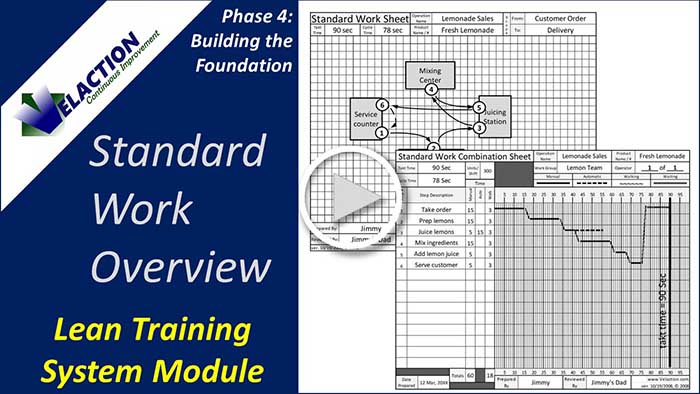> Continuous Improvement Articles
The Standard Work Process: Overcoming Obstacles to Making Effective Standard Work
The standard work process is a critical piece in the implementation of Lean manufacturing programs. It helps to stabilize a process and it provides a basis for continuous improvement. No matter how good something is, though, there is always a cost to it. For standard work, the price can come in the form of hard feelings and subsequent lack of engagement that it can cause in some employees.
In fact, the same aspect of standard work can raise job satisfaction for some people and reduce it for others. Why? Because people are unique. For example, those who love predictability and structure thrive under the standard work process. But those who are more independent, free spirits dislike feeling micromanaged and resent feeling forced to do their work in specific ways.
So, how can leaders make standard work more appealing to employees? A good way to start is to make sure that standard work is structured in a way that it makes it easy for team members to get help when they need it.
Let’s assume that the manufacturing managers are doing a lot of things right:
- there are andon lights in place to call for assistance, and teams are encouraged to use them
- there is a defined sequence of events that happens when the lights are turned on
- leaders enforce the process, and make sure people respond as required
- there are team leaders who can float and offer assistance when help is needed
Read more below this form.
Despite these efforts, employees may still perceive that they are not getting the help that they need when there is a problem on the shop floor. Big problems tend to get a lot of attention, but often the hiccups that frustrate employees are the little things that cost a few minutes here and there.
This is about the small problems that seem to randomly occur in Lean production. A screw gets cross-threaded. A bolt gets dropped into a hard-to-access place. Murphy (remember Murphy’s Law–what can go wrong, will) loves to hang out on the shop floor.
The frustrating part for an employee comes when there is no way to get help to get back on track. Even if someone from a support team shows up immediately, an extra set of hands (if standard work is improperly structured) might not be able to speed things up. Frequently, the helper comes to assist and can do little more than watch, offer advice, or get tools for a person. None of these things will, in most cases, prevent a disruption to production.
Instead, standard work should be arranged so that an assistant can show up and jump right into a task to keep things flowing. It is much easier to do than you might imagine.
The goal is to simply structure the process so that the last few tasks are independent of the rest of the work. That means:
- Put all multi-operator work first. That way, if one person falls behind, the other person won’t get her work flow out of sync.
- Put the most complicated tasks first, so if there is a problem, the operator can light the andon as early as possible.
- Don’t put all the independent work at the same station. For example, instead of having one station apply all the decals to a product at the end of an assembly line, spread the work out among the stations. That work likely can be done at any time, and gives a floater something to do when he shows up.
- Put the tasks with the lowest quality parts first. If a part is bad, there is time to get a replacement. If it is identified right before a line shifts, there is little time to resolve the problem. (Of course, if you know about an ongoing problem, you should also be working to fix it.)
- Start with all sub-assemblies completed. Finish the cycle by building the subs for the next line shift. If an operator falls behind, an assistant can come over and build the subs, buying time for the operator.
- Make sure tools are available for the assistant to work at the same time as the operator. The helper should not have to wait around because a $5 tool is not available.
- The assistant should be trained in the support task. She has to be able to step right in seamlessly. She should practice these tasks for every station she supports, so there is never any hesitation, and no risk of poor quality.
With these fairly simple steps, the employees working in production jobs can feel like they are supported. This will make the pace seem more manageable if they feel like there is a pressure valve (that works!) when things get a little hairy. If employees feel supported, they are much more likely to support the standard work process in return.

0 Comments